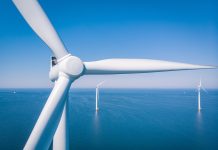When Shell’s logo pops up on a gas station about every few miles while driving down a street or interstate, it’s sometimes easy to forget that the global energy company is involved in so much more than oil and gas.
As a matter of fact, Shell has had a hand in the wind-energy industry for more than 15 years starting with the Rock River project in 2001.
Just in the U.S. alone, Shell maintains an energy capacity of 425 MW from wind energy, according to Tim Russell, power and general manufacturing — sector marketing manager with Shell Lubricants.

“Shell became investors and developers of a number of wind farms in the U.S. and in Europe a number of years ago,” he said.
Shell has an onshore wind portfolio that includes four joint venture interests that span six operating wind projects. Those projects are 50-50 non-operated ventures.
In addition to U.S. wind, Shell also maintains a 50 percent interest in NordZee Wind, an offshore wind park in the Netherlands.
Building new business models
By investing in areas such as the Netherlands and the supply of power to retail customers in the U.K., Shell has been able to take advantage of its existing gas and power trading capabilities while building new business models for the future.
With the cost of wind generation decreasing, the desire to create renewable energy resources continues to interest Shell.
But Shell’s foray into the wind industry doesn’t stop with its wind-farm portfolio.
Shell also works with wind turbine and wind-turbine component manufacturers through its Lubricants division.
“We supply all of the major manufacturers in the sector, whether it’s with greases, hydraulic oils, or gear oils.”
Symbiotic relationships
When it comes to lubricants and the OEMs, it’s important to have a symbiotic working relationship, according to Russell.

“We have a partnership mentality with our customers,” he said. “Supplying today’s requirements on time and with the right products is critically important, as is ensuring that our lubricants and grease portfolio are aligned with the new developments in technology in the industry.”
 Shell is an active player in the energy system and has embraced its transformation into different areas in order to create commercial opportunities while providing cleaner energy worldwide.
Shell is an active player in the energy system and has embraced its transformation into different areas in order to create commercial opportunities while providing cleaner energy worldwide.
And as the offshore business continues to boom abroad and as it gains a foothold in the U.S., Shell is ensuring its lubricants are a part of traditional turbine gearboxes as well as turbines with direct drive.
“One of the bigger changes is going to be what type of lubrication is needed,” Russell said. “As far as requirements go, the direct drive is going to take a different type of lubricant.”
The gearbox challenge
However, the gearbox has always been one of the biggest challenges in a turbine, according to Russell, and he said Shell is coming out with a new gearbox oil that it introduced at AWEA WINDPOWER in May. Shell has developed a premium gearbox oil, Shell Omala S5 Wind, which in testing has proven to be the best performing in the industry.
“Using synthetic oils means gearboxes last longer,” Russell said. “Wind-farm operators and owners want to extend their oil change intervals and with Shell Omala S5 Wind, we have tested that the oil will perform for 10 years without need for a changeover.”
Other good news is that wherever a turbine is located, Shell Omala S5 Wind performs even in the coldest temperatures.
“With such a good quality synthetic, you’re going to cover most of the operating temperature ranges that you’re going to need,” he said.

Looking to the future
Shell’s broader energy plans involve matching the net carbon footprint of the global energy system by 2050, but, in the interim, the company hopes to reduce that footprint by 20 percent as soon as 2035.
Electricity, including from renewable sources, will be a large part of Shell’s future as the world moves to lower-carbon energy. By doing so, Shell expects it to become the fourth pillar of its business, alongside oil, gas, and chemicals.
“Our business priority is to dramatically reduce the net carbon footprint,” Russell said. “Renewables, in particular, wind power, is definitely a significant factor in our strategy.”



























